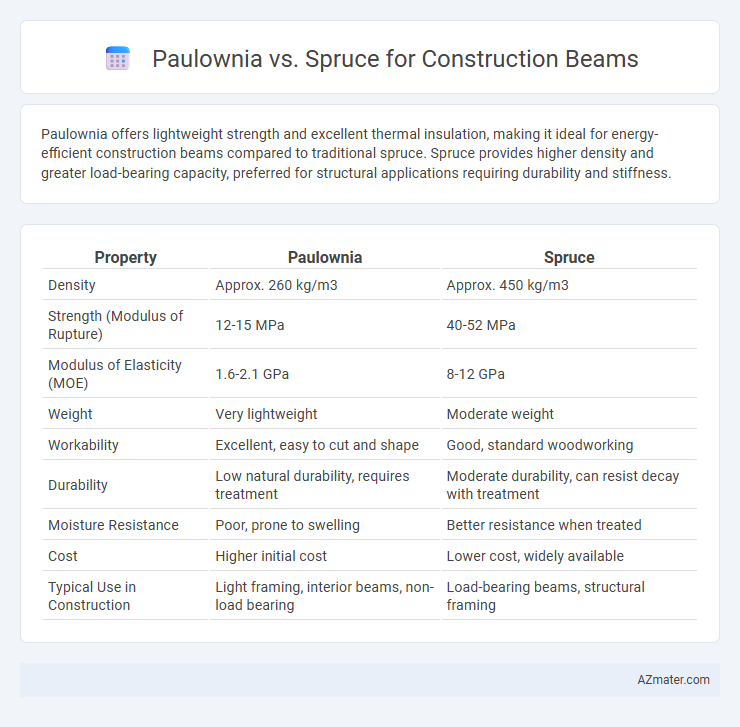Paulownia offers lightweight strength and excellent thermal insulation, making it ideal for energy-efficient construction beams compared to traditional spruce. Spruce provides higher density and greater load-bearing capacity, preferred for structural applications requiring durability and stiffness.
Table of Comparison
| Property | Paulownia | Spruce |
|---|---|---|
| Density | Approx. 260 kg/m3 | Approx. 450 kg/m3 |
| Strength (Modulus of Rupture) | 12-15 MPa | 40-52 MPa |
| Modulus of Elasticity (MOE) | 1.6-2.1 GPa | 8-12 GPa |
| Weight | Very lightweight | Moderate weight |
| Workability | Excellent, easy to cut and shape | Good, standard woodworking |
| Durability | Low natural durability, requires treatment | Moderate durability, can resist decay with treatment |
| Moisture Resistance | Poor, prone to swelling | Better resistance when treated |
| Cost | Higher initial cost | Lower cost, widely available |
| Typical Use in Construction | Light framing, interior beams, non-load bearing | Load-bearing beams, structural framing |
Introduction: Comparing Paulownia and Spruce for Construction Beams
Paulownia and Spruce are commonly used woods for construction beams, each offering distinct advantages in strength, weight, and durability. Paulownia is known for its lightweight and rapid growth, making it an eco-friendly option with good dimensional stability, while Spruce provides higher stiffness and load-bearing capacity favored in structural applications. Understanding the mechanical properties such as modulus of elasticity and density is crucial when selecting between Paulownia and Spruce for specific construction beam requirements.
Physical Properties: Paulownia vs Spruce
Paulownia wood is significantly lighter than spruce, with a density of around 260 kg/m3 compared to spruce's 450 kg/m3, making it advantageous for weight-sensitive construction beams. Although spruce exhibits greater compressive strength and stiffness, typically around 40 MPa and 11 GPa respectively, Paulownia offers superior dimensional stability and resistance to warping due to its low shrinkage rates. The higher strength-to-weight ratio of Paulownia can be beneficial in applications requiring lightweight yet durable beams, although spruce remains preferable for heavy-load structural frameworks due to its higher modulus of elasticity.
Strength and Load-Bearing Capacity
Paulownia wood is significantly lighter and less dense than spruce, resulting in lower strength and reduced load-bearing capacity compared to spruce beams. Spruce, commonly used in construction, offers higher compressive and bending strength, making it more suitable for structural applications requiring durability and heavy load support. Engineers often prefer spruce for beams due to its superior mechanical properties and reliable performance under stress.
Weight and Density Differences
Paulownia wood is significantly lighter than spruce, with a density ranging between 270 to 350 kg/m3 compared to spruce's 400 to 470 kg/m3, making Paulownia an ideal choice for lightweight construction beams. The lower density of Paulownia reduces overall structural weight without compromising moderate strength, which is beneficial for applications requiring easy handling and transportation. Spruce beams, while denser and heavier, offer superior load-bearing capacity and durability, preferred in traditional construction where strength and stiffness are critical.
Durability and Resistance to Decay
Paulownia wood offers exceptional resistance to decay due to its natural oils, making it highly durable in moist environments compared to spruce, which is more prone to rot and fungal attacks without proper treatment. Spruce, while lighter and commonly used in construction beams, requires chemical preservatives to enhance its durability and decay resistance. The superior decay resistance of Paulownia reduces maintenance needs, making it a preferable choice for outdoor and high-moisture construction applications.
Workability and Ease of Machining
Paulownia wood is significantly lighter and more workable than spruce, offering superior ease of machining due to its low density and fine grain structure. Spruce, while denser and harder, provides greater strength but can be more challenging to cut and shape, requiring sharper tools and more effort. For construction beams where ease of machining and rapid handling are priorities, paulownia presents a distinct advantage over spruce.
Cost and Availability in the Market
Paulownia beams are generally more expensive than spruce due to limited supply and slower market diffusion, despite their superior lightweight and rot-resistant properties. Spruce remains widely available and cost-effective, making it the preferred choice for most construction projects seeking a balance between price and structural integrity. The regional availability of spruce ensures a consistent supply chain, whereas paulownia's niche cultivation restricts its market presence and accessibility for large-scale construction.
Environmental Impact and Sustainability
Paulownia wood offers a significantly lower environmental impact compared to spruce due to its rapid growth rate, requiring less land and water resources while sequestering carbon faster, which enhances sustainability in construction. Spruce, although widely used in construction beams for its strength and availability, grows slower and involves more intensive forestry practices that can lead to biodiversity loss and longer carbon cycles. Selecting Paulownia for beams reduces deforestation pressure and supports sustainable forest management practices, making it an eco-friendlier choice for green building projects.
Applications in Modern Construction
Paulownia wood offers a high strength-to-weight ratio and excellent durability, making it ideal for lightweight construction beams used in prefab housing and modular buildings. Spruce, known for its consistent grain and load-bearing capacity, remains a preferred choice for traditional framing, roof trusses, and structural supports in commercial and residential projects. Both woods serve distinct purposes in modern construction, with Paulownia excelling in innovative, eco-friendly designs and Spruce prevailing in conventional, load-intensive frameworks.
Conclusion: Choosing the Right Wood for Construction Beams
Paulownia offers exceptional lightweight properties and rapid growth, making it an eco-friendly choice for construction beams requiring easy handling and sustainability. Spruce, known for its high strength-to-weight ratio and durability, remains the preferred option for structural applications demanding long-term load-bearing capacity. The best wood for construction beams depends on specific project requirements such as strength, weight, environmental impact, and budget constraints.

Infographic: Paulownia vs Spruce for Construction Beam
 azmater.com
azmater.com